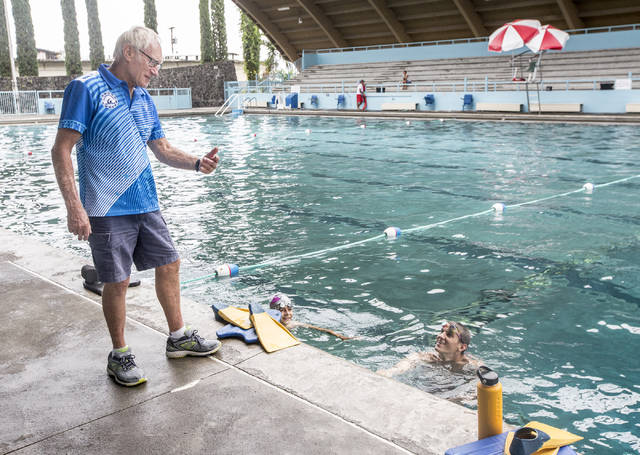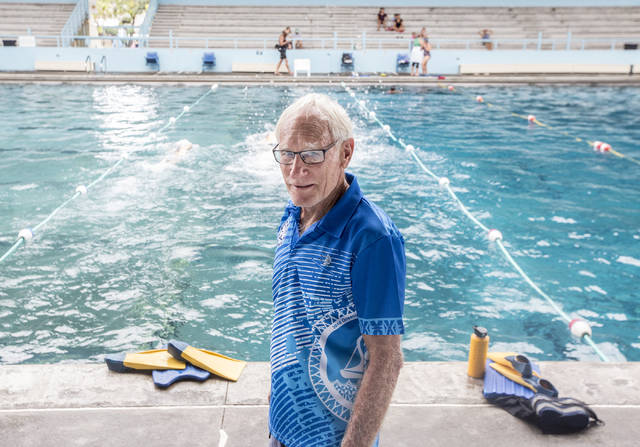A statement by the United Nations a year ago on International Volunteer Day had the effect of crystallizing the legacy of longtime Hilo resident and swim coach Bill Sakovich.
Sakovich is known locally for coaching Waiakea High School and Hilo Aquatics Club teams, while wife Jean worked with him on the club team and coached swimming at Hilo High.
But the UN officially recognizes Sakovich as the “Father of Swimming in the Pacific,” which followed his induction into the Northern Marianas Sports Hall of Fame, for the manner in which he almost singlehandedly created swim clubs in that part of the world.
After more than 40 years of high level coaching and training and extensive work in organization and development of swim clubs, Sakovich – who will be inducted into the Hawaii Swimming Hall of Fame in September on Oahu – was asked the other day if there were a particular achievement that stands out for him over all the years.
“Yes,” he said, almost immediately. “They have happened several times, one just recently — Grayson Goodale. He came to me four years ago and didn’t know how to swim. He left Waiakea with a little scholarship money he plans to use at a school in Oregon.”
Goodale did not set school records or BIIF records. He did not lead the school to state championships. But in his time at Waiakea, he learned how to swim, then he learned how to improve his technique, then he learned how to compete so that his career in the pool was marked by constant improvement.
“For me,” Sakovic said, “that’s about as good as it gets. It doesn’t get the attention some of the others do, but it really and truly is what this is all about — opening opportunities for young people through swimming.”
But you don’t get to be known as the Father of Swimming in the Pacific because you helped a student with some scholarship money after you showed him the possibilities through swimming. In a way, it started at a level with a lot of Grayson Goodales, like the untrained collection of folks he encountered in Saipan back in 1974 when he and Jean started a swim club where there was none.
Prior to his role as an evangelist for swimming throughout the Pacific, Sakovich, a Bay Area native, graduated from UCLA and joined the Peace Corps, which sent him all over, instructing and working with local groups in places like Indonesia and Morocco. He joined the Army Reserves and was sent to Hilo after a training stint at Schofield on Oahu and a short time at Haleiwa beach.
In Hilo, Sakovich was trained by Big Island legend Ed Kawachika who had helped Ohio State win Big Ten swimming and diving championships in the mid-1950s before he returned home and took over Hilo Aquatics Club from 1956-2004. Sakovich directed age-group swimmers at the club from 2004 to 2016.
Connected through his contacts who supported his efforts, Ed and Jean started traveling to different locations in the South Pacific, teaching, encouraging swimmers everywhere they went.
In Saipan, there was no competitive pool in 1974, so they trained in the ocean. Fortunately, Jean had a job at a local hotel and found a way for them to occasionally use a small, kidney-shaped pool to learn turns and get some small feel for pool competition.
“Everybody was interested and wanted to get involved,” Sakovich said, “it was just that they had never been asked in this kind of way.”
It didn’t happen overnight, but in time, Sakovich took swimmers to competitive meets throughout the Pacific, to Australia, New Zealand, across Asia, and they eventually competed at invitational and World Championship levels. His swimmers consistently medaled in Micronesian Games, South Pacific Games and Arafura Games (wherein athletes with a disability compete in the same program as able-bodied athletes every two years in the Australia), until the Sakovichs’ returned to Hilo in 2004.
Sakovich spent 14 years on the executive board of the Oceania Swimming Association, an organization that still tugs at him in a way, to this day.
Later this week, he will join eight local swimmers at the Oceania Swimming Championships, held in Port Moresby, Papua New Guinea, June 23-29. The competition is held on a different island every two years, with all islands in the Pacific invited. Hawaii was invited and USA Swimming gave permission for Hawaii Swimming to select an all star team to compete under the banner of USA. All swimmers must be qualified and must be residents of Hawaii.
It’s a prestigious stage for the 15 -18 year-olds from the state who will be competing.
The “Great Eight” are boys Joseph Ahia, Jaek Horner, Tyler Murakami and Michael Petrides all from Oahu. Girls competing are Maile Lawson from Kona, Sydnee Whitty and Grace Monahan from Oahu, and Jasmine O’Brien from Maui.
Coach is John Flanaghan from Kamehameha Swim Club on Oahu, and medical staff Dar and Randy Gerber. Sakovich is the team manager.
“It’s going to be another great opportunity for these young kids,” Sakovich said. “That’s what keeps me going, I guess. It wasn’t until I got to Saipan way back when, and I started working, and building with these interested groups that I realized how much fun it could be.
“The travel was a lure, no doubt,” he said, “but once we got started, the possibilities were the motivator and the people made it happen.”
It has been, and still is, work that motivates him. It’s not the money.
“Ha!” he said, when as asked facetiously about the riches that come with being the Father of Swimming in the Pacific. “All these executive boards I served on, race director so many times, all the rest, didn’t pay a penny. You don’t do this for money.
“You do it to be a part of something, to help people reach their goals. At the high school level, the kids have to want it, but when they get involved you have that school component — the academic side — to keep them going, keep them striving.
“When you see them start to improve and you see the look in their eyes when they see that that time? You know they get it at that point, you know that the little change you made in their stroke helped them and that they can feel the improvement as they swim.
“That’s what this business is all about,” he said.
In time, you might get to travel to Papua, New Guinea to compete, but it all starts with jumping in and learning the finer points of swimming from one of the most respected teachers in the game.
“I don’t think any of us do this seeking honors or money or any of that stuff,” he said. “But, at the same time, it is nice to know people who know swimming think enough to recognize you.”
Questions? Whistleblower tips? Comments? Contact Bart at barttribuneherald@gmail.com


